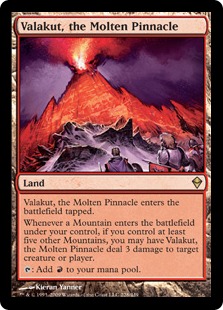Are you a Quiet Speculation member?
If not, now is a perfect time to join up! Our powerful tools, breaking-news analysis, and exclusive Discord channel will make sure you stay up to date and ahead of the curve.
One of the most interesting trends that has emerged over the last few weeks in the Modern is the resurgence of combo-control. Several decks have seen success with an interactive shell that has some sort of a combo finish. Be it Living End suiting up with Cryptic Commands and Remands instead of its traditional creature-heavy shell, UR Breach buying time until it can put together Through the Breach and Emrakul, or Blue Tron pairing counterspells with a big-mana strategy, combo-control is definitely on the upswing.

This article will examine some of the root causes of this surge, and why some decks that seemingly have similar characteristics have not enjoyed the success of the above examples.
Combo-Control's Renaissance
Combo-control's shiny new standing sharply contrasts its condition a few months ago, when Counters Company and Storm were the go-to options if you wanted to play a combo deck in Modern. While those decks are still successful, the metagame has shifted to allow the hybrid decks mentioned above to join them as playable options. In a sense, this is a return to Modern's roots---combo-control had long maintained a steady presence in the format, thanks to its ability to use interaction to buy time and combo finishes to steal otherwise losing games. However, its share began to erode when bannings eliminated some of its foremost exemplars, and the emergence of powerful, streamlined aggro-combo decks like Infect made the remaining options for this archetype subpar choices.
Background Causes
What causes these decks to succeed? I believe a combination of factors fuels the success of these archetypes: new printings have either enabled or benefited them; their metagame positioning has improved; and the pure combo versions of these decks have been facing stiffer opposition lately in the form of hate cards. This section focuses on how these factors apply to the aforementioned decks, and covers one deck which they do not influence.
New Technology
New cards tend to juice up combo-control decks. The foremost example of this phenomenon is the mono-blue Living End lists that have been doing well online of late:
Living End, by 1310HaZzZaRd (5-0, MTGO Competitive League)
This deck exists thanks to As Foretold, Curator of Mysteries, and Striped Riverwinder in Amonkhet block. The new cards provide a means of casting Living End in a mono-blue deck as well as adequate payoffs for doing so.
While other combo-control decks have not been enabled to this degree by recent printings, useful cards have still come to them over the past few sets. Tron decks in general have benefited greatly from Walking Ballista, and Blue Tron is no exception. In the case of UR Breach, having another quality one-drop cantrip in Opt to help dig into combo pieces or utility has made quite a difference, as demonstrated by the following 8-0 list from a PTQ:
UR Breach, by Rooney56 (8-0, PTQ #11039156)
While it’s worth noting that some Blue Moon decks are choosing Kiki-Jiki, Mirror Breaker as a combo finish over Breach, UR Breach is the more popular of the two. Its main selling point: its combo is significantly more difficult to disrupt---not much stops an Emrakul on the battlefield, and not every deck can interact with instants.
Metagame Positioning
Next, let’s examine the position of these decks in the current Modern metagame. The current metagame features a variety of disruptive control and midrange decks at its top end, along with big mana exemplars Titanshift and Gx Tron. All these matchups generally favor combo-control, which can fight back against opposing disruption, and boasts combos that put them far ahead. Furthermore, the midrange and control decks tend to be favored against the fast aggressive decks that punish combo-control strategies for having a slower clock than pure combo and a more limited interaction suite than pure control---the strength of midrange and control then boosts combo-control indirectly, as well. For an example of a deck that benefits from this positioning, let’s take a look at a Blue Tron list from a MTGO competitive league:
Blue Tron, by shoktroopa (5-0, MTGO Competitive League)
A deck that can draw so many cards and produce this much mana is favored in virtually any sort of long game, making life difficult for the midrange and control decks that seek to contain it. Big mana opponents seeking to overwhelm interactive foes with sheer card quality are also in trouble. However, Blue Tron doesn’t boast much in the way of hard removal or permission, which can make its early game dicey. This deck greatly benefits from “fun police” decks keeping the faster stuff at bay. An argument can be made that sister deck Gx Tron is also strong against midrange and control, but Blue Tron being favored against other big mana decks (including in the Tron pseudo-mirror) gives it a viable niche.
UR Breach and mono-blue Living End attack on a similar, but distinct, axis: rather than employing a big-mana aspect for sky-high inevitability, they instead threaten combo finishes that essentially end the game if they resolve. That, plus their capacity to fight back against opposing interaction, means that opponents trying to keep these decks down can’t afford to draw the game out too long.
Hate for Pure Combo
 An important step that should be kept in mind when evaluating a combo-control deck is to compare it to a more focused combo strategy. If the “all-in” version of the combo exists and does well, the niche for the combo-control version feels much more precarious. Each of today's covered decks has a similar strategic analog that is significantly more invested in comboing off quickly: mono-blue Living End and the original Living End; UR Breach lines up most neatly with Grishoalbrand; Blue Tron has to withstand comparisons to Gx Tron.
An important step that should be kept in mind when evaluating a combo-control deck is to compare it to a more focused combo strategy. If the “all-in” version of the combo exists and does well, the niche for the combo-control version feels much more precarious. Each of today's covered decks has a similar strategic analog that is significantly more invested in comboing off quickly: mono-blue Living End and the original Living End; UR Breach lines up most neatly with Grishoalbrand; Blue Tron has to withstand comparisons to Gx Tron.
In the case of all of these decks, certain popular hate pieces greatly hinder their respective strategies. The combo-control version of each deck is better built to fight against these cards. Living End has to deal with Relic of Progenitus (currently the 9th-most played card in the format); Gx Tron has to fight through Blood Moon (16th); and Grishoalbrand’s reanimator aspect is shut down by Relic as well as Grafdigger's Cage (27th).
Beating hate cards is easier with more interaction (in the case of mono-blue Living End and Blue Tron), or with a way to find the more robust combo pieces (as with UR Breach). If you’re expecting a lot of hate for your combo deck of choice, dumbing it down might be the way to go.
Why Not Scapeshift?
And now, we come to a bit of a conundrum in our analysis; I’ve glossed over what some might consider Modern's quintessential example of combo-control in Temur Scapeshift. Here’s an example list:
Temur Scapeshift, by teagantime (5-0, MTGO Competitive League)
This deck was a longtime mainstay in Modern up until Splinter Twin’s banning, then seeing its meta share devoured by its all-in cousin, RG Valakut. The deck has since been relegated to fringe status, putting up results here and there, but never coming close to its former glory. Do any of the factors mentioned above bolster the deck’s cause? Could a resurgence in Temur Scapeshift be on the horizon? I'm leaning towards no.
The first category where Temur Scapeshift falls short is in the new technology department. While cards such as Search for Azcanta, Pull from Tomorrow, and Supreme Will have been bandied about as potentially worth testing in the deck, none has managed to make much of an impact. Even if these cards happen to be successful, they represent incremental improvements at best---the guts of the deck have not changed.
Secondly, Temur Scapeshift fails the positioning test when compared to RG Valakut, as demonstrated by this list:
RG Valakut, by zildjian88 (5-2, Modern Challenge #11051396)
Valakut is already strong against most midrange and control startegies by virtue of its big-mana plan, so Temur Scapeshift doesn’t pick up many points there.
It's also prepared to face early-game aggression thanks to the combination of maindeck Lightning Bolts (which it shares with Temur Scapeshift) and sweepers (which Temur does not feature). One could argue that Temur Scapeshift’s playset of Remands would help delay opponents on combo gameplans, but looking back at the current top decks reveals that pure combo decks are not only relatively few and far between, but many also feature enough mana production to absorb a single Remand and keep right on going, with Counters Company and Storm being the foremost examples. Remand also feels somewhat inadequate when compared to ramping harder when facing the likes of Affinity, Burn, Humans, and often Shadow (a delve threat, a flashed-back spell, or Kolaghan's Command being the only palatable targets). The only matchups where Temur Scapeshift seems to have an edge are big-mana mirrors, and those are not common enough to reward a pilot for switching.
 Last but not least, RG Valakut is arguably just as good at fighting off hate as its combo-control cousin, as it features more copies of Valakut, the Molten Pinnacle (improving its odds against land destruction) and fetchable pieces of artifact/enchantment destruction thanks to Summoner's Pact (a plan for Blood Moon). While Temur Scapeshift does run all of these tools as well, it’s often a turn or two slower than Valakut, meaning it’s heavily diluting its main gameplan for just marginal payoffs. These factors indicate that even if the combo-control renaissance continues, Temur Scapeshift will likely remain a thing of the past, barring future improvements to its card pool.
Last but not least, RG Valakut is arguably just as good at fighting off hate as its combo-control cousin, as it features more copies of Valakut, the Molten Pinnacle (improving its odds against land destruction) and fetchable pieces of artifact/enchantment destruction thanks to Summoner's Pact (a plan for Blood Moon). While Temur Scapeshift does run all of these tools as well, it’s often a turn or two slower than Valakut, meaning it’s heavily diluting its main gameplan for just marginal payoffs. These factors indicate that even if the combo-control renaissance continues, Temur Scapeshift will likely remain a thing of the past, barring future improvements to its card pool.
Going Off
The metagame trends that have brought these combo-control decks to the forefront have shown no signs of abating, so I would expect all of the decks discussed in this article to maintain a presence in the format. If you have any combo-control decks that you think might be poised to make a move in the near future, or know of any combo decks that could potentially be transitioned over into a combo-control variant, I'd love to hear about them in the comments.



